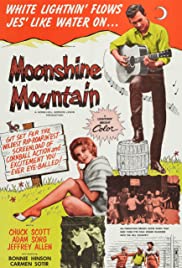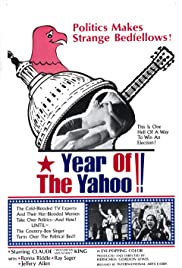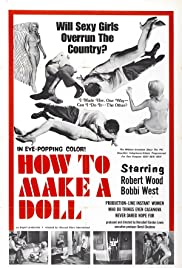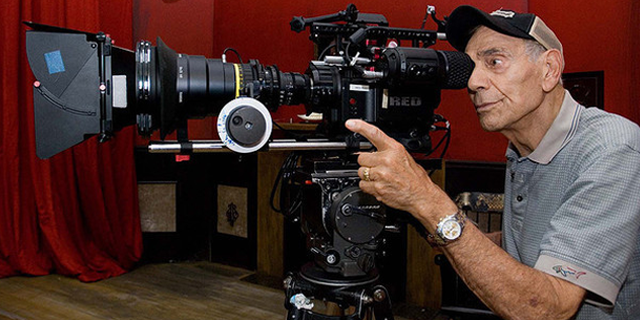The Gutter Trash Maestro series will be dedicated to focusing on directors who have slummed it in the margins producing flicks often on very low budgets but delivering the goods and delighting audiences despite their limited resources and possible dubious motives.
H.G. Lewis came from a background in advertising, having produced marketing materials and commercials for various clients before partnering with producer David F. Friedman in the motion picture business (with an emphasis on “business”). That advertising background would prove to be the primary driving force in Lewis’ filmmaking career as he and Friedman would gleefully bounce from genre to genre as tastes dictated, churning out something cut-rate they could get into drive-ins quickly to make a buck and move on. After a series of early nudie cuties, Lewis and Friedman saw a desire for the red stuff in films that Hollywood wasn’t giving the average joe, so they graced the world with Blood Feast, a laughably incompetent effort that nonetheless has catapulted to cult classic status due to its unprecedented use of gore. The drive-in crowds ate it up, and Lewis sought to give them more. He would continue to deliver genre fare throughout the ‘60s and into the early ‘70s until he basically decided to retire from making movies because he just didn’t see the money in it anymore. For the rest of the ‘70s through the ‘90s, he focused his efforts on his original work in advertising, becoming a successful copywriter and author of books on marketing. In recent years before his death, he had dipped his toe back into the genre with Blood Feast 2 and The Uh Oh Show as well as embracing his role as “Godfather of Gore” at festivals and conventions. Regardless of his motivations, Lewis’ tendency to write, direct, shoot and edit his films himself certainly gave his movies a singular vision and style that cements him as a sewer auteur extraordinaire.

Scum of the Earth (1963)
The roughie had a brief moment of popularity amongst the skeevy grindhouse crowd in the mid ‘60s, particularly those who had gotten bored with regular nudie cuties and wanted to see something more extreme. And since the sex act itself on screen was still a bit taboo, many of these sexploitation films resorted to a focus on degradation and humiliation of the female characters involved. Naturally Lewis couldn’t resist contributing to the sub-genre when there’s a buck to be made. So what we have here is a depressing story of a teenage girl who gets blackmailed into participating in a nude photo sex ring where she is abused and imprisoned by the gangsters behind the racket. I’m generally not a fan of roughies anyway, and Lewis’ effort did nothing to change my mind on the matter. They’re generally unpleasant and sleazy movies lacking the sense of fun that often is associated with z-grade grindhouse flicks.

Moonshine Mountain (1964)
Another type of film that gained some popularity in the ‘60s and ‘70s is what is colloquially known as the Hick Flick, movies that focused on southern culture, often involving bootlegging. Dukes of Hazzard is probably the most well-known of these kinds of entertainment. Hick flicks tended to play well in the south at drive-ins where more unsavory material like nudie cuties and roughies may have otherwise offended the more conservative sensibilities. Lewis’ hicksploitation effort is about as dull as one would expect. A large chunk of the film is taken up with hillbillies sitting around talking about nothing in particular and occasionally singing country songs. It eventually introduces a conflict between some moonshiners and the corrupt local police that the main character gets caught in the middle of, but it feels like too little, too late. Most of the audience will have already fallen asleep by that point.

The Ecstasies of Women (1969)
As standards became more lax in the late ‘60s softcore (and eventually hardcore) sexploitation films rose in prominence, all but replacing the fairly tame by comparison nudie cuties and roughies from earlier in the decade. While in the late ‘60s it still wasn’t common to see sex films with actual penetration, that didn’t mean they didn’t get away with a whole lot they previously had only dreamed of. Of course, Lewis wasn’t going to let the perverts of the world sit empty-handed waiting on a GEN-U-WINE Lewis sexploitation film they could get comfortable with. In fact, he actually produced several over about a 5-year period including The Alley Tramp, Linda & Abilene, Black Love, Miss Nyphette’s Zap-In and the one I just watched, The Ecstasies of Women (you can easily identify his sex films because they were the only ones he used a pseudonym on). Ecstasies is a pretty basic setup for a sex flick. A man is out with his buds at a strip club for his bachelor party (complete with topless go-go dancers gyrating in the background every time it cuts to them) reminiscing about his past “conquests” as he prepares for a life of domestication. Every flashback gives us a different flabby, writhing coupling to witness until the movie decides to call it a day. It’s all pretty dull and dated. Unless you are an H.G. Lewis completionist, there’s no reason to watch this (or actually most of these I just sat through).

Year of the Yahoo (1972)
In 1972, political disillusionment was at an all-time high with the Vietnam War dragging on, civil rights issues flaring up in full force since the late ‘60s and the Watergate scandal breaking, showing the inherent fallibility of the modern president in very stark terms. As a result, audience demand for political films rose, particularly those that showed the internal machinations and base corruption involved in the political structure. Lewis decided to throw his hat in the ring as a political film contender for that sweet audience cash. Taking a cue from the far, far, far, far superior A Face in the Crowd, Lewis’ film Year of the Yahoo is about a corn-pone country singer who is recruited to run for Senate in a ploy to unseat the political rival of a sketchy governor. Like A Face in the Crowd, this singer cum political candidate eventually starts to exert his own thoughts and opinions, throwing a monkey wrench in the whole scheme. The main thing to note is that Claude King, who plays the country singer (and was apparently a country singer in real life) is no Andy Griffith at all. He has all the charisma of a piece of burnt toast and probably tastes worse. You get the sense that Lewis was just too big for his britches here, trying to capitalize off a combination of hicksploitation and political films and not really delivering much of interest to either audience.

She-Devils on Wheels (1968)
The Wild One is often considered the film that really kicked off the big bikersploitation craze in the ‘60s which culminated in the critical adulation of Easy Rider in ‘69. Unlike Easy Rider or The Wild One though, most biker films were lowbrow, trashy fare that existed solely to show a rowdy bunch of hoodlums drink, punch and fuck their way through every town they rode into. These films were often fairly plotless, more a series of violent vignettes strewn together with some kind of loose narrative, usually involving a rival gang, revenge, or authorities on a manhunt. Lewis’ She-Devils on Wheels goes the first route, in this case a rival gang of only men who look down on “The Maneaters”, the all-girl gang that act as our conduits into this world of hot shot races and terrorizing locals. Overall, this is actually pretty tame for a biker movie with little to no sexual content, and not even much violence. There’s a big brawl involving somebody getting beaten with a chain and a delightful decapitation in classic Lewis Blood Feast-style but little else of note. Still, the sassy dialogue and fun characters make this one fairly watchable regardless, especially for an H.G. Lewis movie.

Just for the Hell of It (1968)
The J.D. film (short for Juvenile Delinquent) arose in the 1950s as concern about teens increased in the straight-laced atomic family era. Visions of unbridled hormones rampaging through the night, drinking, drugging, smashing and sexing anything in their way ripped through the minds of parents and authority figures of the day, causing an uproar that brought forth a tide of movies that capitalized on this fear mongering. Movies like Rebel Without A Cause and The Blackboard Jungle brought these kinds of films into the mainstream and tackled the problems in a more serious and empathic way, but they continued to flourish in the margins as well. Lewis’ J.D. film Just for the Hell of It comes pretty late in the teensploitation cycle. By 1968 the counterculture movement had grown so large that adults were no longer concerned about just regular teens breaking stuff and talking back and had moved on to worry about drug dealers, bikers, porno peddlers, rapists, murderers and all other manner of depravity. Lewis gives it the ol’ college try anyway though. The movie is nearly plotless, cutting between a gang of youths breaking shit, running amok, and the hapless innocent guy who gets blamed for it. It’s a pretty pointless, aimless movie only recommended if you want to see a bunch of guys smashing furniture and yelling at people for for a while for no reason.

How to Make a Doll (1968)
Another odd trend that popped up in the mid to late ‘60s and continued on into the ‘70s was the sexy sci-fi comedy. America was fixated on the big space race to get to the moon and what better way to relieve anxiety than by some wacky zero-G hanky panky. The Dr. Goldfoot films were early entrants that mixed comedy, sci-fi concepts and sexy ladies into a heady brew, but the film that most likely created more of a demand for the sub-genre was Barbarella, featuring the shapely Jane Fonda in a series of interstellar sexy shenanigans. Soon to follow were others like Space Thing, Flesh Gordon and Wham Bam Thank You Spaceman to titillate and fuel the imagination. Lewis’ sexy sci-fi flick How To Make A Doll offers a plot that presages the success of the John Hughes film Weird Science about a scientist unlucky with the ladies who does the only logical thing: make his own. It’s a doofy romp that is largely unfunny, mostly relying on one-liners and cheeseball reaction shots for its comedy while it seeks to offer ultimate male wish fulfillment with a parade of totally subservient women. Dumb, incredibly sexist, boring and pretty unnecessary. So basically, like most other H.G. Lewis films.
As a final word on the man, H.G. Lewis is quite possibly one of the most inept directors to achieve the level of notoriety normally reserved for cult filmmakers who actually have skill but, despite that, his films have a certain stripped down, lazy charm that embodies the entrepreneurial spirit of the American dream more than many much more technically competent filmmakers who claim to be in it to grace the world with their unique artistic visions. What I think I’m getting at here is that I feel like Lewis is a filmmaker you can trust. All his cards are on the table, and you can either take it or leave it.

